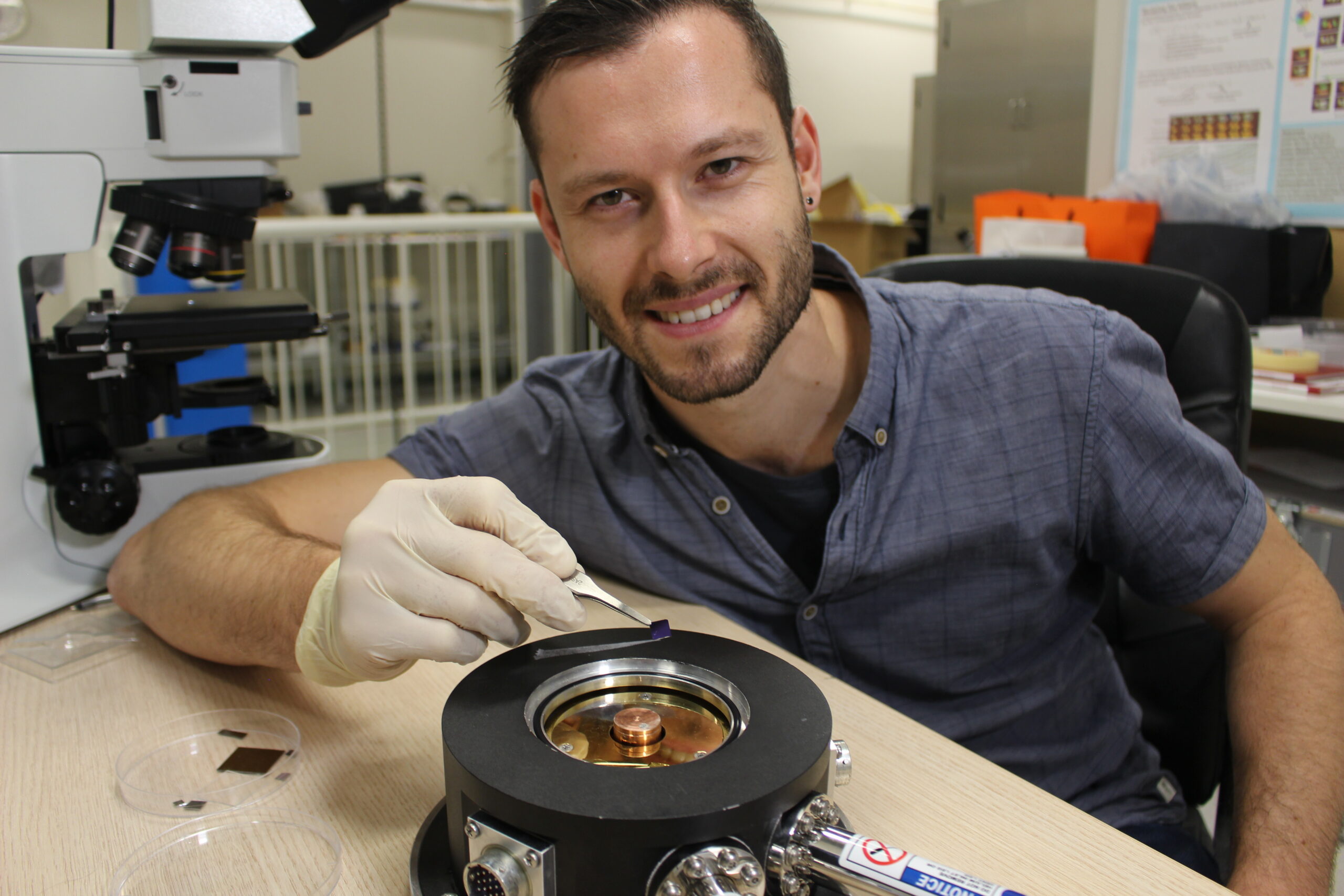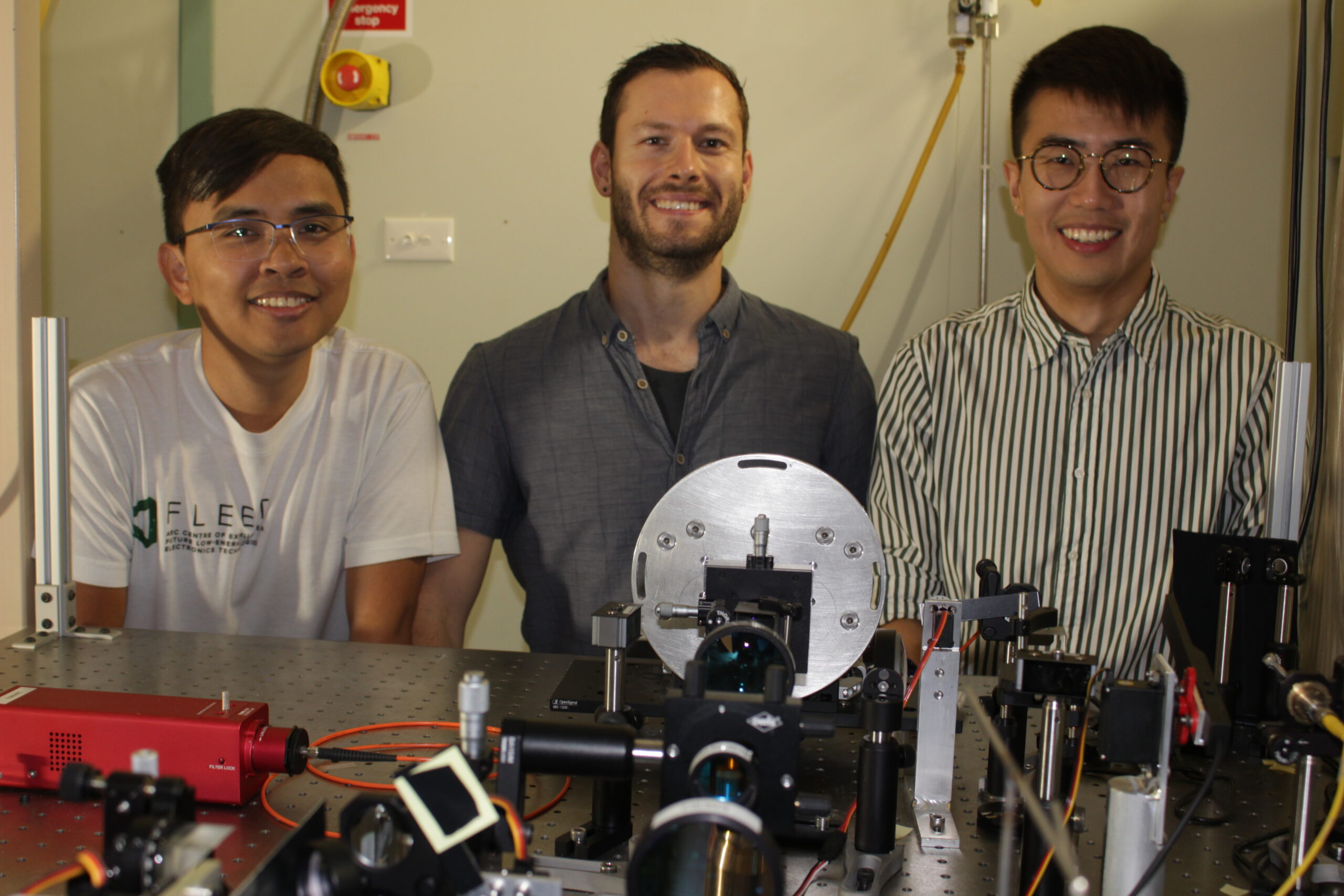Engineering a novel supersolid state using layered 2D materials

Can a solid be a superfluid? Bilayer excitons form a quantum supersolid
A collaboration of Australian and European physicists predict that layered electronic 2D semiconductors can host a curious quantum phase of matter called the supersolid.
The supersolid is a very counterintuitive phase indeed. It is made up of particles that simultaneously form a rigid crystal and yet at the same time flow without friction since all the particles belong to the same single quantum state.
A solid becomes ‘super’ when its quantum properties match the well-known quantum properties of superconductors. A supersolid simultaneously has two orders, solid and super:
- solid because of the spatially repeating pattern of particles,
- super because the particles can flow without resistance.
“Although a supersolid is rigid, it can flow like a liquid without resistance,” explains Lead author Dr Sara Conti (University of Antwerp).
The study was conducted at UNSW (Australia), University of Antwerp (Belgium) and University of Camerino (Italy).
A 50-year journey towards the exotic supersolid
Geoffrey Chester, a Professor at Cornell University, predicted in 1970 that solid helium-4 under pressure should at low temperatures display:
- Crystalline solid order, with each helium atom at a specific point in a regularly ordered lattice and, at the same time,
- Bose-Einstein condensation of the atoms, with every atom in the same single quantum state, so they flow without resistance.
However in the following five decades the Chester supersolid has not been unambiguously detected.

Alternative approaches to forming a supersolid-like state have reported supersolid-like phases in cold-atom systems in optical lattices. These are either clusters of condensates or condensates with varying density determined by the trapping geometries. These supersolid-like phases should be distinguished from the original Chester supersolid in which each single particle is localised in its place in the crystal lattice purely by the forces acting between the particles.
The new Australia-Europe study predicts that such a state could instead be engineered in two-dimensional (2D) electronic materials in a semiconductor structure, fabricated with two conducting layers separated by an insulating barrier of thickness d.
One layer is doped with negatively-charged electrons and the other with positively-charged holes.
The particles forming the supersolid are interlayer excitons, bound states of an electron and hole tied together by their strong electrical attraction. The insulating barrier prevents fast self-annihilation of the exciton bound pairs. Voltages applied to top and bottom metal ‘gates’ tune the average separation r0 between excitons.
The research team predicts that excitons in this structure will form a supersolid over a wide range of layer separations and average separations between the excitons. The electrical repulsion between the excitons can constrain them into a fixed crystalline lattice.
“A key novelty is that a supersolid phase with Bose-Einstein quantum coherence appears at layer separations much smaller than the separation predicted for the non-super exciton solid that is driven by the same electrical repulsion between excitons,” says co-corresponding author Prof David Neilson (University of Antwerp).
“In this way, the supersolid pre-empts the non-super exciton solid. At still larger separations, the non-super exciton solid eventually wins, and the quantum coherence collapses.”
“This is an extremely robust state, readily achievable in experimental setups,” adds co-corresponding author Prof Alex Hamilton (UNSW). “Ironically, the layer separations are relatively large and are easier to fabricate than the extremely small layer separations in such systems that have been the focus of recent experiments aimed at maximising the interlayer exciton binding energies.”
As for detection, for a superfluid it is well known that this cannot be rotated until it can host a quantum vortex, analogous to a whirlpool. But to form this vortex requires a finite amount of energy, and hence a sufficiently strong rotational force. So up to this point, the measured rotational moment of inertia (the extent to which an object resists rotational acceleration) will remain zero. In the same way, a supersolid can be identified by detecting such an anomaly in its rotational moment of inertia.
The research team has reported the complete phase diagram of this system at low temperatures.
“By changing the layer separation relative to the average exciton spacing, the strength of the exciton-exciton interactions can be tuned to stabilise either the superfluid, or the supersolid, or the normal solid,” says Dr Sara Conti.
“The existence of a triple point is also particularly intriguing. At this point, the boundaries of supersolid and normal-solid melting, and the supersolid to normal-solid transition, all cross. There should be exciting physics coming from the exotic interfaces separating these domains, for example, Josephson tunnelling between supersolid puddles embedded in a normal-background.”
The study
Chester Supersolid of Spatially Indirect Excitons in Double-Layer Semiconductor Heterostructures was published in Physical Review Letters in February 2023. (DOI 10.1103/physrevlett.130.057001)
Sandwich-style construction: towards ultra-low-energy exciton electronics

New microcavity construction technique allows observation of robust, room-temperature exciton transport
A new FLEET-led ‘sandwich-style’ fabrication process placing an atomically-thin semiconductor between two mirrors allows a significant step towards ultralow-energy electronics based on exciton-polaritons.
The breakthrough, led by PhD candidate Matthias Wurdack at ANU, demonstrated robust, dissipationless propagation of an exciton mixed with light bouncing between the high-quality mirrors.
Conventional electronics relies on flowing electrons, or holes (a hole is the absence of an electron, i.e. a positively-charged quasiparticle).
Instead, FLEET’s ANU team investigated an alternative future electronic technology using excitons because, in principle, they could flow in a semiconductor without losing energy by forming a collective superfluid state. Also, excitons in novel, actively-studied atomically-thin semiconductors are stable at room temperature. Despite this promise for low-energy electronics and sensors, the properties of
atomically-thin semiconductors, including the flow of excitons, are strongly affected by disorder or imperfections, which can be introduced during fabrication.

The ANU-led FLEET team – with Centre colleagues at Swinburne University of Technology and FLEET Partner institution Wroclaw University – coupled the excitons in an atomically-thin material to light, to demonstrate for the first time their long-range propagation without any dissipation of energy, at room temperature.
Trapping light between two parallel high-quality mirrors in an optical microcavity an exciton (matter) to bind with a photon (light), forming the hybrid particle an exciton-polariton. Microcavities are micrometre-scale structures with an optical medium sandwiched between ultra-reflective mirrors, used to confine light such that it forms exciton-polaritons.
In the 2021 study, a new ‘sandwich-style’ fabrication process for the optical microcavity allowed the researchers to minimise damage to the atomically-thin semiconductor and to maximise the interaction between the excitons and the photons. The exciton-polaritons formed in this structure were able to propagate without energy dissipation across tens of micrometres, the typical scale of an electronic microchip.
A high-quality optical microcavity ensuring the longevity of the light (photonic) component of exciton-polaritons was the key to these observations. “We found that exciton-polaritons can be made remarkably stable if microcavity construction avoids damage of the fragile semiconductor sandwiched between the mirrors during fabrication,” says Matthias.
“The choice of the atomically-thin material in which the excitons travel is far less important than the construction.”
“We fabricate the entire top structure separately, and then place it on top of the semiconductor mechanically, like making a sandwich. Thus we avoid any damage to the atomically-thin semiconductor, and preserve the properties of its excitons.”

The researchers optimised this sandwiching method to make the cavity very short, maximising the exciton-photon interaction.
“This demonstration, for the first time, of dissipationless transport of room-temperature polaritons in atomically-thin TMDCs is a significant step towards future, ultra-low-energy exciton-based electronics,” says group leader Prof Elena Ostrovskaya (ANU).
Furthermore, the researchers confirmed that exciton-polaritons can propagate in the atomically-thin semiconductor for tens of micrometres (easily far enough for functional electronics) without scattering on material defects. (In fact, the travel length of excitons in these materials is dramatically reduced by these defects.) The exciton-polaritons’ high coherence bodes well for their potential as information carriers.
“This long-range, coherent transport was achieved at room temperature, which is important for development of practical applications of atomically-thin semiconductors,” said Matthias.
If future excitonic devices are to be a viable, low-energy alternative to conventional electronic devices, they must be able to operate at room temperature, without the need for energy-intensive cooling.
Motional narrowing, ballistic transport, and trapping of room-temperature exciton polaritons in an atomically-thin semiconductor was published in Nature Communications in September 2021 (DOI: 10.1038/s41467-021-25656-7)
Advancing quantum interaction understanding in 2D semiconductors

Unlocking fresh insights into the behaviour of quantum impurities within materials
An international theoretical study led by Monash University researchers introduced a novel approach known as ‘quantum virial expansion’ – a powerful tool to uncover the complex quantum interactions in 2D semiconductors.
This breakthrough holds potential to reshape our understanding of complex quantum systems and unlock exciting future applications utilising novel 2D materials.
The study of ‘quantum impurities’ has far-reaching applications across physics in systems as diverse as electrons in a crystal lattice and protons in neutron stars. These impurities can collectively form new quasi-particles with modified properties, essentially behaving as free particles.
The new technique shows remarkably good agreement with experimental results, essentially perfect at high temperature with small discrepancies at lower temperatures.
Although a straightforward many-body problem to state, quantum impurity problems are difficult to solve.
“The challenge lies in accurately describing the modified properties of the new quasi-particles,” says Dr Brendan Mulkerin (Monash), who led the collaboration with researchers in Spain.
The study offers a novel perspective on exciton-polarons as impurities in 2D materials – bound electron-hole pairs immersed in a fermionic medium.
As a solution to the problem, the Monash team introduced the ‘quantum virial expansion’ (QVE), a powerful method that has long been indispensable in ultra-cold quantum gases.
In this case, integrating QVE into the study of quantum impurities meant that only the interactions between pairs of quantum particles needed to be taken into account (i.e. rather than interactions between large numbers of particles). The resulting, solvable model sheds new light on the interplay between impurities and their surroundings in 2D semiconductors.

The new approach is remarkably effective at relatively high temperatures (e.g. in a semiconductor anything above a few degrees Kelvin) and low doping (where the electrons’ thermal wavelength is smaller than their interparticle spacing), leading to a ‘perturbatively’ exact theory (referring to a quantum system being perturbed from a simple, solvable limit).
“One of the most intriguing aspects of this research is its potential to unify different theoretical models, with the ongoing debate surrounding the appropriate model for explaining the optical response of 2D semiconductors being resolved through the quantum virial expansion,” says corresponding author A/Prof Jesper Levinsen (also at Monash).
The quantum virial expansion is expected to have a broad impact, extending its applications to various systems beyond 2D semiconductors.
“Understanding quantum impurity physics will continue to reveal insights and unlock novel properties and new possibilities for understanding, harnessing, and controlling quantum interactions,” says corresponding author Prof Meera Parish (Monash).
“Exact quantum virial expansion for the optical response of doped two-dimensional semiconductors” was published in Physical Review Letters in September 2023 (DOI: 10.1103/PhysRevLett.131.106901)
Hybrid particles surprise with negative mass

Unlocking counterintuitive exciton-polariton behaviours to probe new physics towards possible future quantum devices
A surprise observation of negative mass in exciton-polaritons has added yet another dimension of weirdness to these strange light–matter hybrid particles.
The experiments with exciton-polaritons carried out by Dr Matthias Wurdack, Dr Tinghe Yun and Dr Eliezer Estrecho, revealed that under certain conditions the dispersion became inverted – equating to a negative mass.
To add to the surprise, the unexpected cause has turned out to be losses.
“We did not expect that – the dispersion followed very unconventional behaviour,” said Matthias.
An exciton is formed from an electron and a hole pairing up in a semiconducting crystal. If this pair then strongly couples to a photon, a hybrid particle known as an exciton-polariton can form.
Exciton-polaritons were first observed more than 30 years ago and have been shown to exhibit remarkable properties, including superfluidity and formation of Bose-Einstein condensates. Around the world a number of research groups are exploring the counterintuitive behaviour of these strange particles in the hope they could underpin future low-energy technologies.
The observation of negative mass sent the scientists, from the group of Prof Elena Ostrovskaya, back to the whiteboard to try to work out what could cause such an effect.
The simplicity of the experiment, a monolayer of tungsten disulfide integrated in a microcavity, meant that it could be approximated with a simple coupled-oscillator model and so left few possibilities for unexpected effects. The team soon realised an imaginary coupling constant, called dissipative coupling, in their calculations replicated their observations.
However, they struggled to make sense of the mathematical model until they looked at other fields, such as microwave cavities, and realised that an imaginary coupling constant could equate to losses from the light–matter system.
To confirm that interpretation, the team reached out to experts in numerical modelling of physics in 2D systems at the Technical University of Berlin in Germany. These experts confirmed that the negative mass could arise from losses – specifically due to interactions between exciton-polaritons and phonons in the atomically-thin semiconductor.
Calculations also showed that, as the exciton-phonon interactions were turned off, the mass went from positive to negative, behaviour that subsequent experiments at ANU reproduced.
Matthias likened the behaviour of exciton-polaritons to that of boats on a lake.
“The phonons in the active material are like waves on the lake which can affect the movement of the boats – redirecting them, causing them to sway and capsize. This reduces their kinetic energies, which overall leads to losses in momentum, energy and occupation numbers,” he said.
In the quest for low-energy technology, scientists go to great lengths to reduce or remove losses, said Eliezer, also from FLEET.
“Typically, we don’t want losses, but here losses have given us something new,” he said.
“It enabled us to introduce a negative mass to the strongly-coupled system.”
The discovery is another facet of exciton-polaritons’ counterintuitive behaviour, Matthias said.
“This behaviour could be used for dispersion engineering, potentially to probe new physics and create as yet undreamed-of devices.”
“I cannot predict the extent of future applications yet using this kind of dispersion engineering, but I am hopeful this will be explored in future research activities,” he said.
Story first published: Australian National University
Negative-mass exciton polaritons induced by dissipative light-matter coupling in an atomically thin semiconductor was published in Nature Communications in February 2023 DOI 10.1038/s41467-023-36618-6



